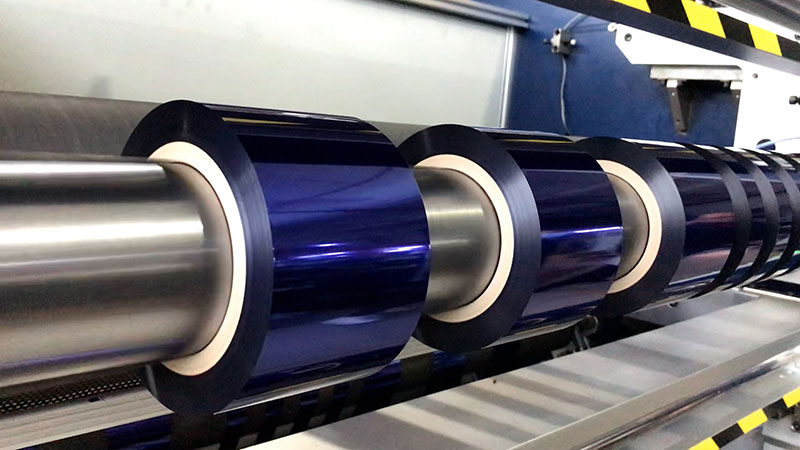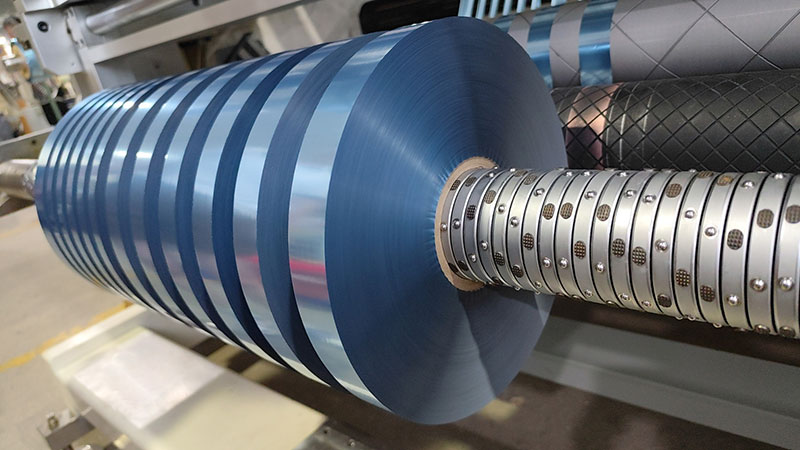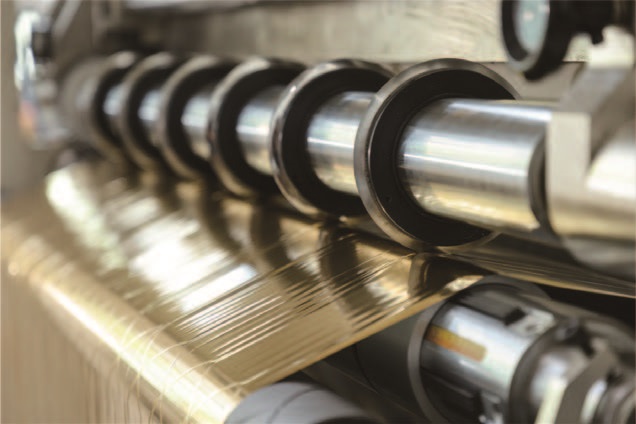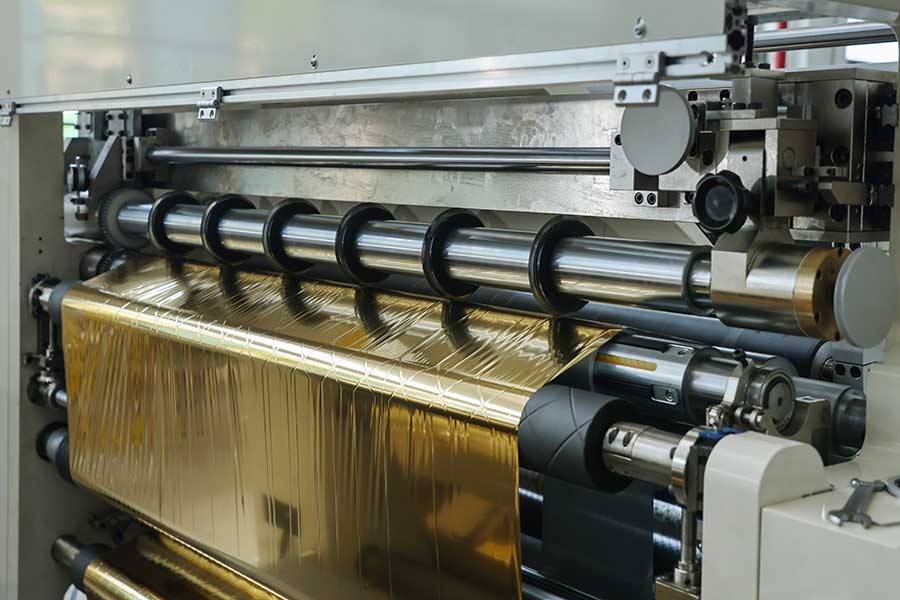The "burr" problem is essentially irregular, fuzzy, fine foil powder or drawing on the edges of the slitted foil strip. This can lead to foil stamping:
1. The edges of the hot stamping pattern are not clear and smooth, and excess gold powder or burrs appear.
2. It is easy to lose powder and contaminate the hot stamping plate and workpiece.
3. Poor transfer, foil breakage or even normal production.
Below I will share from two aspects: cause analysis and practical solutions.

First, analysis of the root cause of burr problems
The factors that cause slitting burrs can be boiled down to three main categories: slitting equipment, slitting process, and hot stamping foil itself.
1. Slitting equipment factors (most critical)
◦ Blade sharpness: This is the most common cause. The passivated blade cannot "cut" the foil, but "squeezes" or "tears" the foil, which will inevitably produce burrs and foil powder.
◦ Blade angle and installation: The mating gap (too large or too small) and the amount of overlap (knife eating depth) of the upper and lower blades are incorrect, which will lead to incomplete cutting.
◦ Knife shaft runout: If there is runout in the knife shaft, it will cause the pressure to be unstable during the cutting process and the local cutting will continue.
◦ Unwinding and unwinding tension: Unwinding or improper tension (too large or too small) can cause the foil tape to shake or stretch during slitting, affecting the stability of the cut.
◦ Guide rollers and over rollers: Worn, grooved or non-smooth guide rollers can scratch the foil surface or cause the foil strip to deviate, indirectly causing burrs.
2. Slitting process parameters
◦ Slitting speed: If the speed is too fast, the cutting frequency of the blade cannot keep up, which is prone to heat and wire drawing.
◦ Ambient temperature and humidity: too dry environment is prone to static electricity, causing the foil powder to fly and adsorb on the cut edge; Excessive humidity can affect the physical properties of the foil.
3. The foil stamping itself factors
◦ Coating quality: The formulation process of the release layer and glue layer is poor, resulting in unbalanced cohesion or adhesion, which is prone to chipping and powder loss during slitting.
◦ Substrate (PET film): The base film is too thick or too hard, which will cause great wear on the blade; Too thin or too soft is easy to stretch and deform, both of which have higher requirements for slitting.
◦ Storage environment: Moisture or too long sitting of the foil may cause changes in coating properties, making it brittle or sticky, affecting the slitting effect.

Second, practical solutions and experience sharing
When encountering burr problems, please follow the troubleshooting principle of "from the outside to the inside, from easy to difficult".
Step 1: Check and adjust immediately (most immediate action)
1. Replace the blade! Replace the blade! Replace the blade!
◦ Say important things three times. This is the preferred operation to solve 90% of sudden burrs. Don't try to sand the old blade, just replace it with a new, high-quality round blade.
◦ Experience note: Establish a record of blade usage and force replacement regularly, rather than waiting until it can't be cut. For highly demanding products, after slitting a certain number of meters, even if it looks okay, it should be replaced.
2. Check and adjust the tool position
◦ Clearance Adjustment: Ensure proper clearance between the upper and lower blades. Usually for thin materials such as hot stamping foil, the gap should be very small, generally 0.001-0.003 inches (about 0.02-0.07mm), or even in a state of "like touching but not touching". Mantra: The gap is small rather than large.
◦ Overlap (knife depth) adjustment: The depth at which the upper knife (round knife) cuts into the lower knife (bottom knife) should be appropriate. Too deep can exacerbate wear and may cut through the PET base film, while too shallow can cut continuously. Generally, the cutting depth is 1/3 to 1/2 of the blade.
◦ Practical skills: When adjusting, you can use a piece of thin paper (such as copy paper) to pull between the knives, feeling that there is resistance but can be cut smoothly, this feel is almost the same.
3. Check and adjust the tension
◦ Unwinding tension: Ensure smooth unwinding without shaking. The tension should not be too large, otherwise the foil will be overstretched.
◦ Rewinding tension: The rewinding tension should be moderate and uniform. Excessive tension will compact the foil tape that has been cut out of the raw edge on the roll, which will look more serious; If the tension is too small, it will be unevenly reeled, and it is easy to cause new problems during operation.
◦ Experience: Observe the foil belt during the slitting process, which should be in a flat, tight but no vibration state.

Step 2: In-depth investigation and maintenance
If the first step cannot be solved, an in-depth investigation is required.
4. Comprehensive equipment maintenance
◦ Check the tool shaft: Check the radial runout of the tool shaft with a dial indicator to ensure it is within the permissible range (usually very strict).
◦ Clean and inspect the guide rollers: Thoroughly clean all guide rollers, touching them with your hands to feel for uneven wear spots. Replace the guide roller in question.
◦ Check the air shaft, slider, etc.: Ensure that all transmission components run smoothly and without loosening.
5. Optimize process parameters
◦ Reduce the slitting speed: Try to reduce the slitting speed by 30%-50% to see if the burr phenomenon improves. If the improvement is obvious, it may be that the blade fit or the material itself is not suitable for high-speed slitting.
◦ Control the environment: If the workshop is too dry, consider using a humidifier or ion fan to eliminate static electricity.
6. Collaborate with foil suppliers to solve problems
◦ Feedback problems: Feedback the problem to the supplier in detail on the batch and phenomenon of the foil roll.
◦ Request sample comparison: Request samples from the same batch and different batches, and do comparative slitting tests on your own equipment. If there is no problem with other batches, it is the quality of the foil; If there are any problems, it may be that your equipment or process does not match the foil of the model.
◦ Explore the adaptability of foils: Some special foils (such as laser foils and anti-counterfeiting foils) are indeed more difficult to slice due to thicker or more special coatings. Talk to your supplier about whether they have a slitting process suggestion or if they can recommend an alternative model that is easier to slit.
Third, summary: Establish a preventive maintenance system
To completely get rid of the problem of burrs, it is not always possible to remedy it after the fact, but to establish a preventive system:
1. Standardized Operations (SOPs): Develop detailed slitting work instructions, including blade replacement frequency, installation standards, tension setting range, speed range, etc.
2. First article inspection: At the beginning of each roll of foil slitting, first use a low-speed slitting section, use a high-magnifying glass to check the quality of the cutting edge, and then speed up mass production after qualifying.
3. Regular maintenance plan: Strictly implement the daily, weekly, and monthly maintenance plan of the equipment, focusing on key components such as tool shafts and guide rollers.
4. Blade Management: Procure high-quality blades and keep records of their use to achieve predictive replacement.
5. Supplier management: Establish long-term cooperative relationships with excellent hot stamping foil suppliers, who can provide more stable and better quality products, as well as professional technical support.
I hope this practical experience can be helpful to you! Solving process problems requires patience and meticulous investigation, I wish you a smooth production!

Every millimeter of precise slitting, every technological breakthrough, silently speaks of the brand's persistent pursuit of perfection.
31. December, 2025
The traditional large-scale standardized production model is gradually transforming into a customized direction with small batches, multiple specifications, and fast delivery.
31. December, 2025
This article will provide an in-depth explanation of the five core technical parameters of hot foil slitting equipment to help you make informed purchasing decisions.
31. December, 2025
With the emergence of high-precision hot stamping foil slitting machines, this industry pain point is being fundamentally solved.
30. December, 2025
The emergence of automated slitting technology is providing innovative solutions to this industry problem.
30. December, 2025